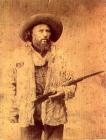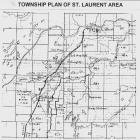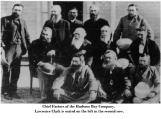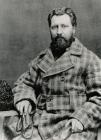1
Painting by Michael Gaudet depicting the St. Laurent settlement.1873
St. Laurent is located on the west side of the South Saskatchewan River, east of the Town of Duck Lake

2
In 1873 the St. Laurent settlement was established. It was located on the west bank of the South Saskatchewan River. In December of 1873 the Metis of St. Laurent established their own government with Gabriel Dumont as the elected president. This governing body then developed the "Laws of St. Laurent".4
Gabriel Dumont emerged as a strong Metis leader. He spoke 6 native languages and french. He had experience in battle and had military instincts. He later gave up the traditional buffalo hunt economy to homestead and operate a general store and ferry south of Batoche.In 1877, the Third Initial Meridian was established, and in 1878, 71 river lots were surveyed, conforming closely to Metis land use patterns. These river lots were 220 yards wide and 2 miles long and faced the river. Later government surveys imposed an artificial grid system based on townships which ignored the Metis system and also hindered filing for title, as the survey maps took 4 years to produce instead of one.
5
Metis river lots at Batoche from 1880 to 1899.1880
The Batoche river lots were located along the South Saskatchewan River, east of the town of Duck Lake

8
Lawrence Clarke, chief factor for the Hudson's Bay Company at Fort Carlton, supported the farming concept based on the H.B.C.'s need for cartmen and suppliers of pemmican. Métis labourers were hired on contract, laid off in quieter periods, and paid in trade goods rather than cash. This system, along with subsistence farming, gave little hope to the Métis of acquiring title to their lands or buying farm machinery.Lawrence Clarke saw the Laws of St. Laurent as a threat to his economic and legal dominance over the Métis lands and people. He worked hard to have the Métis code superseded by Canadian Law, which he enforced through the N.W.M.P.
10
Métis frustration grew with little or no response to petitions sent to the government for title to their lands. The Métis council, therefore, resolved to send a delegation to Montana to recruit Louis Riel to act as their spokesman to the government. They wrote a letter to Riel on May 6, 1884. It was delivered to Riel in Montana by G. Dumont, J. Isbister, M. Ouellette and M. Dumas. Riel accepted and moved his family back to Canada and settled in Batoche.11
Riel's leadership was accepted by the Métis, the First Nations population and the white settlers. Each group voiced their grievances to him.The treaty promises made to the First Nations people were to ensure security against future uncertainties, hardships and starvation but in 1879 nothing had been done to fulfill them. They were given inferior farm implements to work with which led to crop failures. When band members left for the hunt to supplement their farming, surveyors came and allotted the reserve land according to the number of people present at the time. Further more, from 1881 to 1884 money was cut from the provisions budget limiting them even more.
Settlers' grievances increased with the increase of eastern presence into the area. In order to be heard, the North West Settler's Union was established with William Henry Jackson as secretary. It's main goal was to set up a local responsible government through the creation of a new province. Other issues included federal land and railway monopolies, high tariffs and the granting of land at a lower price to favored individuals.
In the fall of 1884 the Bill of Rights was drawn up, which addressed all these grievances, and sent to Ottawa. Due to the lack of response to the bill a petition was sent in February 1885.
12
William Henry Jackson produced the paper "Voice of the People", which covered settlers' grievances.1885
Unknown




